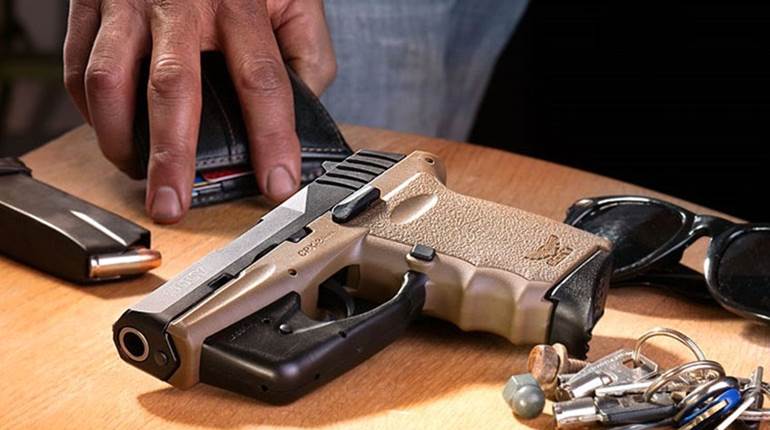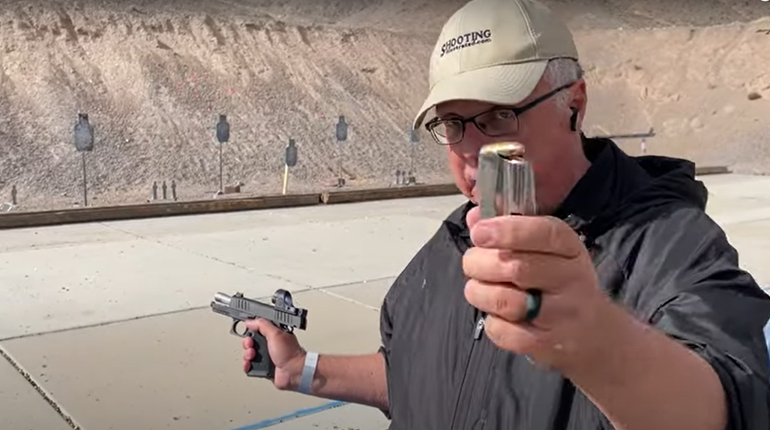
It’s no surprise that the War on Terror has generated a lot of interest in American military rifles. This same fascination was piqued by the 1903 Springfield .30-06 Government after World War I, the M1 Garand after World War II and the M14 (M1A) after Korea. American shooters are instinctively drawn to military style rifles, and with good reason.
Military rifles are interesting. Unlike commercially developed firearms, military rifles are subjected to exhaustive testing and stringent performance requirements.
The rifle that’s currently captivating America’s shooting public is the semi-automatic version of the M4 carbine because it closely resembles the rifle of our military forces. The distinguishing features of an M4 are a flat-top Picatinny rail upper receiver for mounting an optical sight; a quad-rail Picatinny fore-end for mounting accessories; a collapsible stock; and a carbine-length barrel. M4 barrels supplied to the military are 14.5-incheslong, but most guns produced for commercial salehave 16-or 16.5-inch barrels.
Objective Testing Standard
There’s a lot to be said for objective standards in testing firearms to determine which of a given category of guns is best. On the other hand, no matter what standard is chosen, someone is bound to have other priorities. In this case, we’re dealing with a civilian version of a military rifle, so it seems logical to use Military Standards as the primary barometer.
I can’t take credit for this approach. The best feature-by-feature testing of MilSpec standards on commercial M4 carbines was conducted by Rob Sloyer of Tacticalyellowvisor.net which is summed up in a chart. I'm condensing Sloyer’s somewhat arcane data and translating it into easily understandable “consumer friendly” language.
Military standards of accuracy and endurance in a rifle are quite different than civilian standards, and not in the way most would expect. In fact, accuracy is a disquieting aspect to a MilSpec M4, which can barely hit the inside of a barn and still meet the Military Standard of a 5-inch group with iron sights at 100 yards. Most shooters—myself included—would not be satisfied with a 5-inch group, but that’s Uncle Sam’s metric for accuracy with the M4. By that generous measure, every commercial M4 carbine passes with flying colors.
Endurance is also important, but again the Military Standard is a rather pedestrian benchmark for a commercial rifle. It’s only 6,000 rounds (200 30-round magazines). A lot of tactical carbine classes require 2,000 rounds, so assuming you practice even semi-regularly, you’ll have exhausted the MilSpec service life of your M4 in no time. I don’t think this is a reasonable standard for a civilian M4, given that we clean our guns more carefully and treat them better than GIs in the sandbox.
Accordingly, let’s give all the M4 carbines out there a bye on accuracy and endurance. Instead, let’s look more closely at the components these guns are made from and whether their manufacturers follow Military Standards for the three most important categories: the lower receiver, barrel and bolt carrier. If you hit the markers for these three core components of an M4, you have a good rifle.
Bolt Carrier Group
The bolt carrier group (BCG) is the heart of an M4, the “moving part” inside the gun that conducts the locking, firing, extraction, ejection and chambering a fresh round. It takes more abuse than any other part of the rifle. The first criterion of a BCG is that it’s made of structurally sound steel.
Since steel “looks” fine even when it’s flawed, the MilSpec is to test the BCG with a high-pressure test (HPT) and a magnetic particle inspection (MPI). A high-pressure test is proof-firing an intentionally over-pressured cartridge.
A high-pressure test does you no good if you can’t see if any microscopic cracks or flaws have developed, which is what a magnetic particle inspection does. Think of it as an X-ray for steel. It “sees” hidden cracks.
The proven way to assure that the steel of a BCG can withstand a high-pressure test and subsequent magnetic particle inspection is to subject the carrier to a process known as shot peening. Basically, this is a metallurgical treatment to surface harden the steel by bombarding it with special particles that act as tiny ball-peen hammers. Few manufacturers go to the trouble.
Another desirable feature is that the carrier itself is an M16 style, which means that the firing pin is fully enclosed so that the hammer is cocked by the BCG and not the firing pin.
Lastly, you want a BCG with a properly staked gas key. The gas key is a crucial component in a direct gas impingement system and some factories simply screw the gas key onto the BCG without staking it in place.
Barrel Basics
The barrel of an M4 carbine should be made from MIL-B-11595-E chrome moly steel if it is to duplicate MilSpec standards. This is a very straightforward “yes or no” question. Colt, LMT, Bravo Company and Sabre are the only manufacturers of commercial M4 carbines to use MIL-B-11595-E steel.
Most other manufacturers use 4150 steel, which is also a chrome moly steel but is not the same alloy as MIL-B-11595-E. I’m not a metallurgist and I can’t comment intelligently on why one barrel steel is better than another, but as noted earlier, we’re using the Military Standard as our way to sort the commercial versions of the M4. It is what it is. You either use MIL-B-11595-E steel or your don’t.
The next thing to look at in a barrel is its structural integrity which requires the same high-pressure testing and subsequent magnetic particle inspecting as the bolt carrier group. To my knowledge Colt, Noveske,Daniel Defense and Lewis Machine & Tool (LMT) are the only manufacturers that test all of their barrels. Other manufacturers only conduct “batch” testing.
You’ve no doubt heard of chrome-lined barrels and chambers—it’s a good thing on the AR platform. It’s another clear-cut “yes or no” question: Most manufacturers chrome their barrels and chambers, but some do not.
The chamber of an M4 carbine should be a 5.56 NATO chamber which is slightly oversized compared to a .223 Rem. chamber. All of the manufacturers we looked at use a 5.56 NATO chamber.
The rifling twist for a MilSpec M4 is 1:7. Most manufacturers use a 1:7; notable exceptions are Smith & Wesson and Armalite which use 1:9 barrels.
Another important consideration in the barrel is that the feedramps are cut in what’s known as an “M4 style.” First implemented by the military on the M4, the barrel feedramps are extended back to match with the feedramps cut into the upper receiver (as opposed to standard feedramps that don’t so extend). Feeding is said to be more reliable with faster-cycling carbines on full-auto fire with M4-style feedramps. It’s another “yes or no” issue. M4 feedramps are there or they’re not.
Receiver Considerations
The lower receiver holds the fire control group, otherwise known as the trigger, hammer and sear, as well as all the other controls for the rifle: pivot pins, magazine release, safety, bolt release and receiver extension. The upper receiver is not all that crucial and is not even considered in Sloyer’s component-by-component comparison. It should have a proper M1913 specification Picatinny rail, but that’s about it.
The receiver extension is the round tube that sticks out the back of the rifle onto which a collapsible stock is attached and inside of which is the spring and buffer that returns the bolt carrier group into battery. If this part fails, you’ve got an expensive black club.
The receiver extension—often called a buffer tube—comes in two sizes: 1.14 inches and 1.17 inches. The 1.14 size is Military Standard, but it’s really inconsequential aside from the fact that we agreed to judge by the MilSpec criteria, and 1.14 is MilSpec. The only difference is that some after-market stocks don’t fit on a MilSpec receiver extension, although most makers offer both sizes.
It’s a good idea to have a heavy buffer, known as an H-buffer, in the buffer tube. The extra weight slows unlocking of the bolt and retards the cyclic rate of full-auto guns. It is MilSpec, so it’s our basis of comparison.
MilSpec also requires the use of .154 inch diameter pins to hold the fire control group (trigger, hammer, etc.) in place. This is important if you’re going to drop in an after-market trigger from Timney, Jewel or Giselle trigger.
Now according to this compilation of MilSpec with the Sloyer’s data comparing commercial M4s component-by-component, Colt’s 6920 is the only commercial AR-style rifle that hits all of the key indicators for military standards. What does this mean? Nothing really, only that the military’s main supplier of MilSpec rifles is following all of the military standards for their civilian rifles.






































